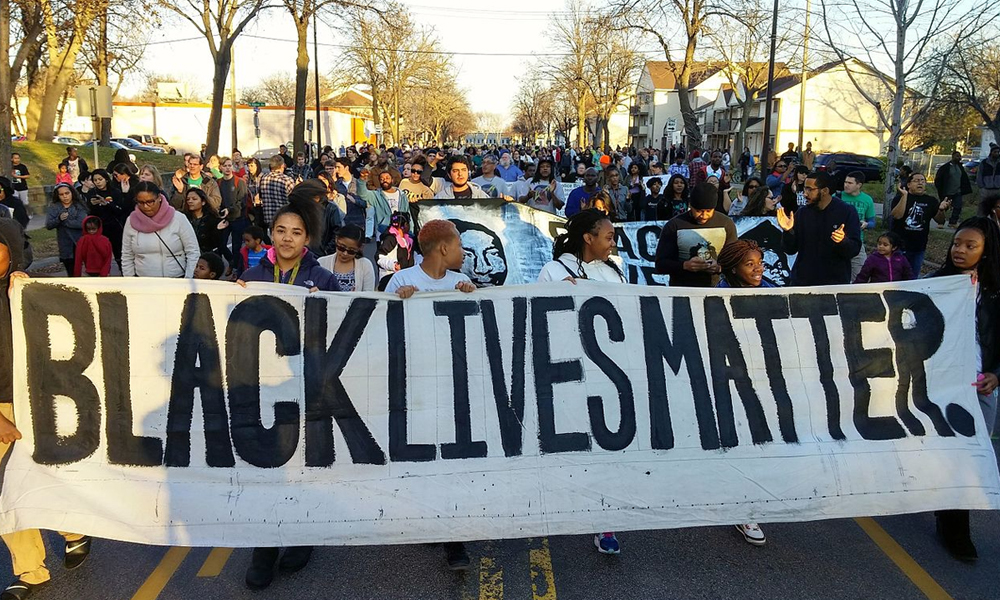
Image Credit: Wikimedia
George Floyd's Killing: Years Of Racial Violence Perpetrated With Impunity Laid Groundwork For Today's Injustice
India, 2 Jun 2020 2:38 PM GMT | Updated 2 Jun 2020 3:10 PM GMT
Editor : Prateek Gautam |
A free soul who believes that journalism, apart from politics, should stand for social cause and the environment.
Creatives : Abhishek M
" An engineer by profession, Abhishek is the creative producer of the team, graphic designing is his passion and travelling his get away. In more ways than one, he makes the content visually appealing."
#BlackLivesMatter began trending on social media in 2013, after a civilian who fatally shot teenager Trayvon Martin in Florida the year before, was acquitted. A movement against systemic violence against the African American community sprung up after the brutal killing.
The last eight minutes and 46 seconds of George Floyd's life was spent in excruciating pain. Handcuffed, pinned to the ground with a white Minneapolis police officer crushing the black man's neck with his knee while ordering him to 'relax', Floyd lost his life gasping, "please, I can't breathe".
Floyd, a 46-year-old African American man, a Minnesota resident, was arrested after he was accused of using a counterfeit $20 note at a local deli. Police said that Floyd "physically resisted" the arrest after he was asked to come out of his car. This claim, however, was belied by mobile phone footage recorded by passers-by.
He was then pinned to the ground till he no longer breathed.
"I Can't Breathe"
George Floyd's name now resonates across America. His last words have become a rallying cry.
From Minneapolis to Los Angeles, New York and Washington, people chant "I can't breathe".
Floyd's death was classified as a homicide, with a medical examiner saying his heart stopped as police restrained him and suppressed his neck. Under "other significant conditions", Floyd suffered from heart disease and hypertension, and listed fentanyl intoxication and recent methamphetamine use. A Minneapolis police officer, Derek Chauvin, has been charged with third-degree murder in Floyd's death. Four other officers have been fired.
The murder has triggered violent unrest in Minneapolis, leading to a state of peacetime emergency being declared in Minnesota state, and also the activation of its National Guard. Concerns over the law enforcement's bias against the African American minority have yet again come to the fore.
Floyd's death has enraged the globe. Crowds across the United Kingdom, Germany, France, Italy, Ireland, Canada, New Zealand and others have joined the chorus of condemnation reverberating around the United States.
Thousands of signs reading "Justice for George Floyd," "Racism has no place," "Enough is enough," and "Black lives matter" have flooded the streets. Chants of "I can't breathe," "No justice, no peace," "Justice can't wait," "Black futures matter," "Suffocate the racists," and "We are all the same and equal," rang in the air.
Latest in a series of deaths of black men and women at the hands of police in the US, Floyd's death on May 25 has prompted people to break the silence.
In New Zealand, thousands walked the streets to protest against Floyd's killing, as well as against police violence and racism in their own country.
Hundreds in Brazil protested crimes committed by the police against black people in Rio de Janeiro's working-class neighborhoods. As police used tear gas to disperse them, demonstrators said "I can't breathe."
An anti-racism protest in Canada led to clashes between Montreal police and some demonstrators.
As protestors torched a Minneapolis police station, capping three days of violent protests in the US, President Donald Trump threatened to take action to bring the city of Minneapolis "under control," calling the protestors "thugs" and saying that "when the looting starts, the shooting starts." To quell the rise of these protests, President Trump threatened to deploy the United States military to American cities.
The Black Lives Matter (BLM) Movement
Floyd's death has prompted comparisons to the death of Eric Garner in 2014. Garner, an unarmed African American man who was held in a chokehold by a police officer in New York City, uttered cries of "I can't breathe" 11 times before he died.
The 2016 shooting of Philando Castile, a 32-year-old black man, is another high profile death. He was shot seven times at close range during a traffic stop by police officer Jeronimo Yanez, who was acquitted of all charges in 2017.
In 2016 again, an incident that caused a lot of unrest was when 37-year-old Alton Sterling was pinned to the ground and shot by police outside a convenience store in Louisiana where he was selling CDs.
A 2016 study by The Guardian revealed that the rate of fatal shootings by police per million people was the highest for the Native American (10.13) and Black (6.6) racial groups. According to a study in the American Journal of Public Health from 2018, the mortality rate by police for black men was much higher (1.9-2.4 per 1 lakh people) compared to 0.6-0.7 for white men.
#BlackLivesMatter began trending on social media in 2013, after a civilian who fatally shot teenager Trayvon Martin in Florida the year before, was acquitted. A movement against systemic violence against the African American community sprung up after the brutal killing.
In 2014, Black Lives Matter gained more prominence during protests against the deaths of Eric Garner and Michael Brown. Brown was also shot dead by police.
The movement was started by three African American women, but later expanded across the US and even internationally.
This decentralised movement pushed to reduce deadly encounters between police and African-Americans, and increased accountability for the same. This included calls for the end of military-style equipment like riot gear, assault weapons and armored personnel carriers being used by municipal forces, officers to wear body cams documenting the events leading up to and during incidents of shooting, among others.
"As You Grow Older, You'll See White Men Cheat Black Men"
George Floyd's brutal killing represents how violence has been used to terrorize black Americans into submission, into a caste position considered inferior, for ages now.
Some scholars have described 'convict leasing' - a system that dates back to the 1940s, under which black people were convicted of crimes under discriminatory "Black Code" laws and then leased to private businesses to work under unimaginably inhuman conditions for state profit - as "worse than slavery". Jim Crow and racial integrity laws at that time prohibited social interactions between people of different races
Lynchings of black men and women emerged soon after, and were widely practiced in the US south from roughly 1877.
In those days, a typical lynching involved a dubious accusation against a black American, which would lead to his arrest, and finally to his killing by a mob whose basic intent was to subvert the normal constitutional judicial process.
In those times, the most unsettling of realities was how white Americans embraced these brutal lynchings. These would be gleeful moments, exciting minutes of wholesome celebration.
When Raymond Gunn, a black man, was killed by a mob in Maryville, Missouri, United States, after he confessed to killing and attempting to rape a white school teacher, the crowd that came to witness the murder was estimated at 2,000 to 4,000. It included hundreds of children.
Many a time, these lynchings were sanctioned by law enforcement and elected officials, who allowed the perpetrators to act with impunity. Angry mobs would often torture their victims publicly for hours, before displaying their brutalised bodies to terrorise other black people.
There were more than 4,400 documented victims of racial lynching between 1877 and 1950, most of whom were killed in the 12 Southern states. Mississippi, Georgia, and Louisiana were among the deadliest of these places.
The experiences of African Americans murdered by mob violence for several generations between Emancipation and the struggle for civil rights have now laid the groundwork for the kind of inequality, injustice and brutality that people like George Floyd face today.
Although fiction, Harper Lee's 1960 novel, 'To Kill A Mockingbird', paints the unfortunate reality that we have to face to this day. The story revolves around lawyer Atticus Finch, who defends a black resident called Tom Robinson who is falsely accused of raping a while woman called Mayella Ewell. Atticus defends him despite threats from the community, and refuses to abandon Tom even as he faces a mob intent on lynching his client.
As Tom is killed while escaping custody, his death is compared to "the senseless slaughter of songbirds."
Something that Atticus said resonates with us even today: "As you grow older, you'll see white men cheat black men every day of your life, but let me tell you something and don't you forget it - whenever a white man does that to a black man, no matter who he is, how rich he is, or how fine a family he comes from, that white man is trash."
Also Read: Digital Giants Twitter, Google Join Protest To Raise Voice Against Racism In United States
 All section
All section














